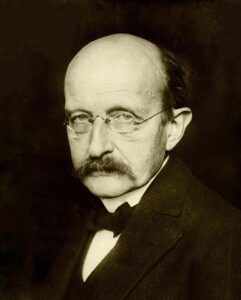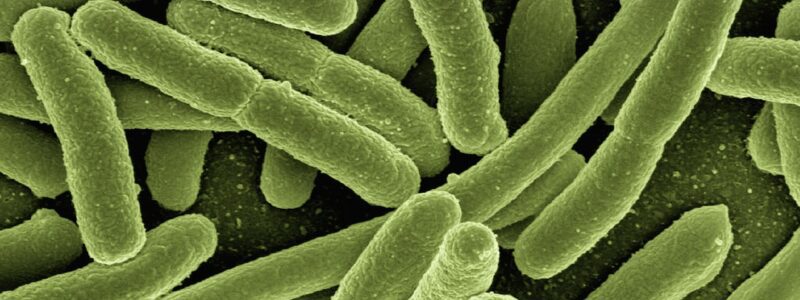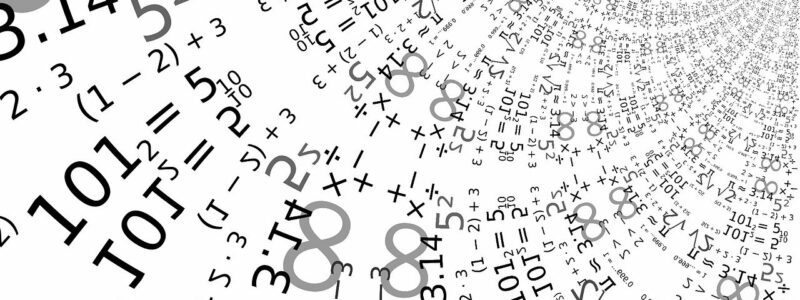Statistics is the Grammar of Science
Sciences take statistics very seriously. Statistics is considered the grammar of science. It is possible to determine whether something is likely true or false using statistical analysis. With this tool, we can tell whether something is likely to happen, or can never happen – statistics is the grammar of science.
The ability to manufacture biological life proteins in the wild by chance is not statistically possible unless there is something very basic we do not understand. We have already shown amino acids were not carried to earth in any quantity by comets or meteors. Only one amino acid has been identified in space – glycine.
Statistics also demonstrate how unlikely it is for biological proteins to be manufactured in the wild by pure chance.
Can You Prove Anything by Statistics?

Image by Robyn Wright from Pixabay
Mondays are always difficult days with a medical clinic. You have frightened, sometimes nearly hysterical patients calling who think they need to be seen ‘right away’ – or that need a medication renewed ‘now’ as they careless ran out over the weekend. Sometimes patients are correct and they need to come to the clinic today, or even take themselves to the Emergency Room where more testing equipment is available.
Mondays are never easy.
And it was on a Monday that Jeff made his unwelcome reappearance. I was right in the middle of a physical examination when the secretary tapped on the door. I thought it rather rude for my secretary to interrupt me, but when she protested that somebody named ‘Jeff’ needed desperately to talk with me right now, I told her to get his return phone number and I would call when I got a chance.
She then informed me that this Jeff would be coming right over to the office if I didn’t call him right now.
The patient graciously excused this interruption. Most patients recognize they would want the doctor to drop everything and attend to them if they ever became so ill as to demand to speak with the doctor. Of course, I didn’t tell this particular patient that the interruption was due to a friend and not a desperately ill patient.
I went back to my office and closed the door, trying desperately to keep this conversation as quickly as possible as I had a full waiting room that day. There is nothing that can produce a bad clinic experience as when the doctor is made late for ten more patients waiting to be seen that morning.

Image by F. Muhammad from Pixabay
“Hello, Jeff – what’s the emergency?”
“Look, Dave, don’t play with me. I’ve had another visit with my angel friend.”
“And I guess you need to discuss what he said to you, right?”
“Yes – look Dave, I need you now; I mean, I don’t know any of this stuff and I need somebody to bounce things off of. You’re the only one who will listen. I’ve tried talking to some of my former girlfriends and – well, you can imagine how that went. Then I have a few other understanding friends around the world – but they just hang up on me.”
“OK, Jeff – I’ll tell you what. Just come over to the office later this afternoon and we’ll sit down and talk.”
“See you then – and Dave, don’t tell anybody else about these visits; I mean, that’s all I need is for my clients to find out I’m having hallucinations or something.”
“No Jeff, it will be strictly between us; the physician-patient relationship and all.”
And with that, Jeff just hung up the phone. I wondered the rest of the day what had happened now; and what to make about Jeff seeing this hallucination, angel – or whatever! I have seen a lot over very disturbed or angry patients and none of them had similar visions at night. Understandably, he didn’t want it to become public knowledge – that could certainly ruin a career.
But I guess what was interesting was the content laden nature of his hallucination. Sometimes, hallucinations might bring up long-forgotten experiences from childhood, or some fears that had long since been forgotten. Still, it was unusual for somebody to have content laden hallucinations; certainly, Jeff had never studied chirality in finance school; where did all of that come from?

Image by sungmin cho from Pixabay
Jeff appeared at my office door late in the afternoon just as scheduled. The front desk was just getting ready to pack up and go home, so his timing was excellent as usual. Nancy, the front desk clerk, led Jeff back to my room and said good-bye for the day. I sat Jeff down in a chair and we began our discussion.
I could see Jeff was troubled again. His usual jocular demeanor was absent, he wanted to get right to the discussion without any pleasantries.
“Dave, thanks for seeing me with such little notice. This is getting to be a real problem; I find my disrupted sleep makes me a zombie the next day! I just don’t know what to make out of all this – do you think I’m going crazy or something?”
“No Jeff, certainly not.” I was not quite as sure of my assessment as my statement let on and needed more time to form a clinical opinion.
“Look, just like before, shortly after I had gotten to sleep I had another vision of this angel guy. It was the same thing; I had just gone to bed and fallen asleep when Boom; he appears again!”
“So, what did the angel say to you?”
“He started with a question; ‘how did life start on Earth?’”
That question seemed to me to be a little strange especially since Jeff had no idea about biology and certainly not about life origins. Books have been written on this topic, and it is very controversial. I am sure this was a rhetorical question just trying to determine the depth of Jeff’s knowledge.
“And what did you say?”
“Well, I told him just what I was taught in school, and what my church never told me otherwise; that life started in some ‘primordial pond’ I think they called it, and that over time – millions or billions of years, it gradually evolved to us today! That’s essentially the sum and substance of evolution. I further told the angel that evolution was settled science, that every reputable biologist believed in evolution, that it was taught in all the textbooks – everywhere that is except for those crazy schools that teach creation science.”
“How did the angel take that?”
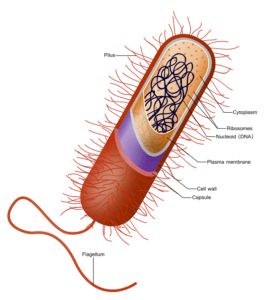
Typical bacteria – By This vector image is completely made by Ali Zifan – Own work; used information from Biology 10e Textbook (chapter 4, Pg: 63) by: Peter Raven, Kenneth Mason, Jonathan Losos, Susan Singer · McGraw-Hill Education., CC BY-SA 4.0, Link
“Actually, not too well. But I held to my guns. I was certain that nobody at reputable accredited universities believed otherwise, and that I was standing on very firm scientific ground. Let me tell you the conversation that happened next.”
“Son of Earth; do you have any knowledge about the details as to how life began on earth?”
“Well – no, not really angel. I mean, I haven’t studied evolution for many years – like twenty years. How am I supposed to remember all of that?”
“Son of Earth, you don’t remember any details as to how life started on earth because nobody knows the details. That is the dirty little secret evolutionary origin of life scientists have; that nobody has a clue as to how the first biological organism came to be.”
“Oh come on, angel – it really isn’t that difficult. The best explanation I have heard is really pretty simple. Out in multiple ponds throughout the world, organic chemicals, energy from sunlight, heat, and lightning gradually formed more and more complex molecules until they became enclosed in a membrane. Those organisms which were better put together tended to survive longer and so natural selection occurred. Gradually, these single-celled organisms joined together to form multicellular organisms which gradually evolved into invertebrates, then fish, reptiles, birds, and mammals. It’s really pretty simple – it’s in every elementary and high school biology text.”
“But is it possible that could explain the origin of life?”
“Well, how the heck should I know – I’m, a stockbroker not a scientist.”
“I understand that, Son of Earth. I am only trying to gauge the level of your ignorance to know where to begin.”
“Now look angel, I’m going to demand to wake up if you’re just going to insult me!”
“Son of Earth, you have no choice but to listen and learn from me; this is not up to a vote.”
“Well, go on then; just get this over with!”
“Son of Earth – do you know what a protein is?”
“Well, sure angel. Protein is like muscle or steak that you eat at the restaurant.”
“Yes, that is correct – but what is a protein made of; how would you make a protein?”
“Oh come on angel – I’ve forgotten all that stuff years ago.”
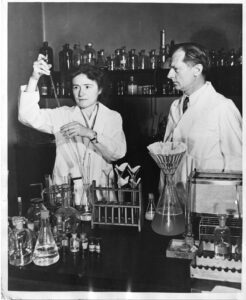
By Smithsonian Institution from United States – Gerty Theresa Radnitz Cori (1896-1957) and Carl Ferdinand Cori (1896-1984)Uploaded by PDTillman, No restrictions, Link
“Son of Earth, a protein is made by splicing together different amino acids together using polypeptide bonds. Let me show you what a polypeptide bond is:
“Do you see the diagram in your head, son of Earth?”
“Yes, but what the heck does that mean?”
“There are only twenty amino acids that are used to make up the thousands of different proteins in your body; the amino acids are paired together in a string-like polymer – each one connecting to the next one with a peptide bond. What happens is that the different amino acids are brought together and the carbon from one amino acid binds to the nitrogen from the next amino acid in the chain; when this occurs, a hydroxyl group (-OH) combines with a hydrogen from the nitrogen to form water; this is called a ‘condensation reaction’ because water is formed.
“Well, that’s pretty cool!”
“The twenty amino acids are all different depending on what they have on their side chain; glycine, for example, has an H or hydrogen as the R group and is the simplest amino acid. Also remember, son of Earth, that only the left-handed amino acid (and not its right-handed cousin) is used.”
“OK angel, that’s very interesting and everything, but why are you showing me all this stuff?
“Well, it turns out, Son of Earth, that after the protein chain is formed, the protein then folds into a specific three-dimensional structure that usually is related to its function. For example, some proteins are enzymes that make chemical reactions go much faster. These enzymes have a specific three-dimensional structure with an ‘active site’ that does all the dirty work of being an enzyme. It any one of most of the amino acids in that enzyme is wrong, then it cannot fold property and the active site may not form. In this manner, the function of the protein is determined by its structure. Are you keeping up with me?”
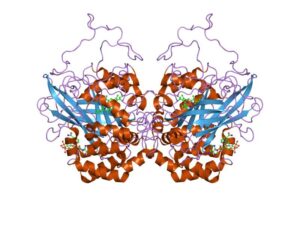
Catalase Protein – By Jawahar Swaminathan and MSD staff at the European Bioinformatics Institute – http://www.ebi.ac.uk/pdbe-srv/view/images/entry/7cat600.png, displayed on http://www.ebi.ac.uk/pdbe-srv/view/entry/7cat/summary, Public Domain, Link
“So far so good!”
“So, how was the initial protein – say the enzyme catalase – formed, Son of Earth?”
“Well, it’s like I said. Over time and with a great many trials and errors over billions of years, amino acids reacted with each other in order to form any given protein such as catalase.”
“And of course, Son of Earth, the chance of that occurring is related to the number of amino acids that have to be in the correct order, right?”
“Well, of course. The more amino acids there are that need to be correct, the longer the time which will be required to build the things. That seems pretty logical so far!”
“Son of Earth, here is the problem. Teachers the world over tell their students exactly what you have said; that given enough time and enough worlds, and sufficient amount of amino acids and an energy source such as the sun, there will inevitably be enough proteins spontaneously created to form life. It strikes me that is why astronomers are always searching for organic molecules in space because they know that where there are organic molecules such as amino acids, along with water, sunlight, and a few other things – life will inevitably form!”
“Son of Earth – I am sorry your education has been so limited; no expert origin of life scientist believes what you just uttered!”
“What! Surely you are misinformed or mistaken – that’s not what I hear from you. Just go on YouTube and you will hear lecture after lecture about how life came from primordial ponds the world over.”
“You might hear that from teachers who are not involved in origin of life research; but when you consult the experts, they will tell you it is impossible to construct even one short 150 amino acid long life protein on earth; and not just on earth – it is impossible throughout the entire universe since the universe began 13.82 billion years ago.”
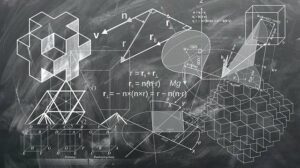
Math and Statistics – Image by Gerd Altmann from Pixabay
“Look angel, you’re clearly mistaken. It seems our roles are reversed; tell me why you have this delusion!”
“Son of Earth, I have been studying biology for the past several million years which is one reason I was chosen as your messenger. Your average scientist is convinced there must be something missing in their understanding of life creation – because a single life protein could never have been produced throughout the entire universe – let along the thousands of important different proteins in your body.”
“Ok, angel, tell me more; how do you come up with this ridiculous assertion that not even life protein could not be formed by chance in 13.82 billion years!”
“Son of Earth, what I am about to tell you is nothing new; indeed, this problem has been discussed at scientific meetings for the past fifty years! For example, there was a meeting at the Wistar Institute in Philadelphia in 1966 entitled “Mathematical Challenges to Neo-Darwinism.”[1] The meeting was chaired by Sir Peter Medawar, a Nobel Prize winner from England, and was held to discuss the growing doubts of many mathematicians, physicists, and engineers regarding the ability of random mutations to generate the information needed to produce new forms of life, and more specifically, regarding the chance of random mutation to produce the first life.”
“Angel, what exactly was the problem; I mean, I thought this was settled science that random change over time would produce new life?”
“The problem, Son of Earth, is that you are wrong. The MIT professors asserted a “combinational problem” whereby the number of possible ways that a set of objects (such as amino acids in a protein) can be arranged increases incrementally as the number of objects increases. It turns out to be extremely difficult to produce a functional protein because there exists a vast number of other possible combinations that do not. Furthermore, as the length of the protein increases, the number of possible amino-acid sequence combinations of that length grows exponentially, and the chances of producing a functional protein decrease precipitously.”
“I’m afraid I just don’t see the problem, angel. I mean, these chemical reactions occur very quickly and certainly could produce large numbers of amino acid combinations in hundreds of years – let along millions!”
“Let us examine the problem, Son of Earth; then perhaps you will see why you – and so many average non-scientists are so wrong just like you are. “
“OK, angel; tell me ‘the truth’” as you see it.”
“Remember Son of Earth, there are twenty different amino acids; therefore, when you put two of them together in a peptide bond dl you have any idea of the number of such combinations?”
“Quite a few, I suppose, but not too many as to be insurmountable!”
“This is a mathematical problem that can be precisely determined, Son of Earth; there would be 202 different combinations of any two amino acids, or 400. But when you get to four different amino acids, there are 204 different combinations or 160,000 different ways they can be combined. Are you starting to see the problem now, Son of Earth?”
“Well, not really; remember that chemical reactions take place very quickly, so it should be possible to produce at least one copy of any four sequenced amino acids in a split second.”
“You are right, Son of Earth, chemical reactions take place very quickly but they do take some time. But consider a 150 amino acid long protein – what turns out to be a fairly small protein remembers that some proteins are thousands of amino acids long.”
“OK, so what, angel?”
“How many different combinations would there be – can you calculate that number?”
“It is easy to calculate, Son of Earth – and you will do so tomorrow in the Excel program found on your computer. But until them, I will tell you that the number of amino acid combinations for a protein that is 150 amino acids long is 20150 or 1.42772 X 10195 – an astronomically large number.”
“Yeah, I guess that is a large problem!”
“But the situation is even worse, Son of Earth. Consider a ‘primordial soup’ that you have thought might explain this problem. First, there are many different ways amino acids can link together; but the only one that produces a protein is a peptide bond. All of the other ways amino acids can chemically react together would form a non-functional protein because it could not fold upon itself correctly.”
“Just how likely are these other ways amino acids can combine?”
“It turns out, Son of Earth, the probability of forming a peptide bond is about 50%; therefore, the chance that a 150 amino acid long protein would have amino acids that only use peptide bonds – and not one of the other types of bonds – is 0.5150 or roughly 1 chance in 1045; again, you will do this on your Excel program tomorrow (the more precise answer is 1 chance in 7.00649 times 1046). But there is another problem we have already discussed, Son of Earth.”
“OK, what is that, angel?”
“That is the problem we discussed during my last visitation; only the left-handed form of an amino acid is used in biological protein synthesis. The probability of this happening is (again) 0.5150 or roughly 1 chance in 1045, so the chance of having all 150 amino acids being left-handed variety amino acids all with peptide bonds is approximately one chance in 1090! Are you beginning to see the problem, Son of Earth?”
“It does look like a very small chance of getting the correct sequence of 150 amino acids that are peptide bonded and of the left-handed variety!”
“Molecular biologists have known for some time that several of the amino acids in a functional protein can be changed without significantly affecting the ability of a protein to function – but the exact answer to this question was not known at the time of this meeting at Wistar in 1966. It would take several more years until several important studies were conducted in the laboratory of Robert Sauer. His research team utilized a sampling technique known as “cassette mutagenesis” to determine how much variability was allowed for a functional protein; they determined that the probability of achieving a functional sequence of amino acids in several small (roughly 100 amino acid long) proteins was approximately 1 chance in 1063.”[2] [3]
“Douglas Axe was another investigator that attempted to rigorously answer this problem. He used a refined method on a functionally significant 150 amino-acid section of a protein called beta-lactamase – an enzyme that confers antibiotic resistance upon bacterial. Axe was able to make careful estimates of the radio of the number of 150 amino acid sequences that can perform the particular function to the whole set of possible amino acid sequences of this length. He estimated the ratio to be 1 in 1077.”[4]
“So Angel, what you are telling me is that despite the ability of some of the amino acids in a 150 amino chain to be changed out to other amino acids and still function as beta-lactamase, the chance of producing a functional protein by chance would be vanishingly small!”
“Exactly correct, Son of Earth. But Axe was able to determine something even more important; namely, the chance of getting any functional protein that is 150 amino acids in length. He did this by determining the frequency of folded sequences that might occur in a 150 amino acid long protein. He determined the ratio of the number of 150 amino acid sequences that produce any functional protein whatsoever to the whole set of possible amino acid sequences of that length. Axe estimated the ratio to be 1 in 1074 implied that the probability of producing any properly sequenced 150 amino acid long functional protein at random is about 1 in 1074.”
“OK, angel, I see your point; scientists have determined that the chances of producing any functional protein that has 150 amino acids are very small – but how small?”
“The chances of producing a single functional protein that is 150 amino acids long is about a billion times less likely than randomly finding a single marked atom in our galaxy.”
“What!”
“Yes, Son of Earth. If I were to randomly select a single atom in the Milky Way galaxy in which we are now living, the chances of your finding this single atom by chance is a billion times better than a single functional protein being formed by chance.”
“But it is even worse than that; remember, we have not yet included the probability of a 150 amino acid chain being composed of only left-handed amino acids and being composed of only peptide bonds. As we previously noted, that chance is 1 in 1090, so the chance of getting one functional amino acid in a ‘prebiotic soup’ is 1 chance in 1073 times 1090 or 10163.”
“That seems like a really small chance, angel!”
“To get some idea as to the remoteness of this possibility, consider that there are only 1080 protons, neutrons, and electrons in the observable universe. Therefore, the chance of getting a functional 150 amino acid protein like beta-lactamase being formed is 84 orders of magnitude (or powers of ten) smaller than the probability of finding a marked neutron with one try in the observable universe. “
“OK Angel, but look; I’ll bet this Axe guy has been hammered by critics; I mean, what do his peers in the scientific community say? Has he published this information in peer-reviewed journals?
“Of course he has critics, Son of Earth; but his work gives at least a first approximation of the difficulty of producing a functional 150 amino acid at one chance in 1077. Remember, Son of Earth, the chance of producing a specific functional 150 amino acid protein exactly is 20150 or one chance in 10195 – so Axe’s work indicates that producing any functional protein of 150 amino acids long is much greater than producing a specific 150 amino acid long protein – certainly an expected finding.”
“His work shows how difficult it is to make functional proteins from random amino acids; any research that counters the prevailing science will be assailed by detractors.[5] But, Axe also has his supporters as well, those who support the simple findings of his research that makes naturalistic evolution very difficult.”[6]
“Angel, you’re hiding something; if it is difficult to produce a functional protein from scratch, I bet an alternative would be just to modify existing ones to produce new functions. I mean, I’ll bet that functional life proteins are all very similar to each other and that only slight modifications of an amino acid or tow might make a new enzyme!”
“You would be wrong in your expectations, Son of Earth. It actually is an area of more recent research by Axe who showed that most enzymes and proteins are quite different from each other. Furthermore, protein structure has been shown to be ‘context-dependent’ – that is, the entire structure of the protein is involved in its function. This means that changes in the structure of a protein would more likely make it less rather than more functional.”
“But it is even worse for the production of life by chance because there are many different proteins in a living cell – and many of these are much longer than 150 amino acids. For example, the typical RNA polymerase – the molecule the cell uses to copy genetic information during transcription (copying of DNA into a messenger RNA) has over 3000 amino acids! In 1983, Sir Fred Hoyle calculated the odds of producing the proteins necessary to service a simple one-cell organism (such as a bacteria) as being 1 in 1040,000.[7] Axe’s experimental findings now indicate Hoyle’s calculations were surprisingly correct. If the probability of producing a 150 amino acid protein is 10164 as outlined above, then the probability of producing all the necessary proteins for a minimally complex cell is 10164 times itself by 250 times – the number of proteins (genes) in a minimally complex bacteria[8] – of 1041,000.”
“Also, Son of Earth, I have chosen a rather small protein to evaluate – only 150 amino acids long. It turns out that the average amino acid length of a life protein is about 350 amino acids long!”[9]
“Look, angel, all of these numbers are interesting, but so what? As I pointed out before, if you take the size of the universe, the amount of time since the universe began, and the speed at which chemical reactions occur – might there not be enough time to produce a simple single-cell bacteria? And remember, all you need is one bacteria that can produce and then you have the well-established process of natural selection taking over.”
“Excellent point, Son of Earth – you are starting to think for yourself rather than merely expressing the thoughts of others. We will now look at how to place numbers on the chance of producing a single simple celled organism.”
“What you are really asking, Son of Earth is if there were enough ‘probabilistic resources’ available to produce life; to do this, you have to calculate the maximum number of events that could actually have taken place throughout the entire universe since the beginning of the universe.[10]
[11]
To make this calculation, you have to know there are about 1080 elementary particles in the observable universe;[12] because there is an upper limit on the speed of light, only those parts of the universe which are visible from the earth can have an effect on the earth.”
“The age of the universe can also be calculated in seconds; the universe began about 13.8 billion years ago[13]
and there are 365.25 days in a year, 24 hours in a day, 60 minutes in an hour and 60 seconds in a day giving 4.4 x 1017 seconds.[14]
“Now that we know the number of particles in the universe and how long these particles have to react, we now have to calculate how many times a second these particles can react with each other. We now have to delve into quantum physics, Son of Earth.”
Quantum Physics and Probability of Functional Protein Formation
“What the heck is ‘quantum physics?’”“It indicates that due to the properties of electromagnetic radiation, there is a limit to the number of physical transitions that can occur from one state of matter to another within a given amount of time. A physical transition from one state to another cannot take place faster, for example, than light can traverse the smallest physically significant unit of distance – called an indivisible ‘quantum’ of space’.
“What is a quantum of space?”
“Son of Earth, you would think that you could theoretically take a length and divide it into two equal lengths indefinitely, would you not?”
“Yes, of course, you would.”
“But this is not the case; quantum physics – which has been proven by literally hundreds of experiments to represent reality – indicates there is a small unit of length that cannot be further shortened; it is the shortest unit of length. It is called the Planck length and is 10-33 centimeters. The amount of time it takes for light to traverse the Planck length is called the Plank time or 10-44 seconds. The Planck time turns out to be the shortest unit of time, just like the Planck distance turns out to be the shortest distance.”
“This is all really strange, angel. This stuff has really been proven correct?”

By No machine-readable author provided. Peng assumed (based on copyright claims). – No machine-readable source provided. Own work assumed (based on copyright claims)., CC BY-SA 3.0, Link
“As much as anything in science, quantum physics has been shown to best represent reality. And now, it has been calculated that there are at most 1043 possible times that elementary particles can interact with each other in a second – a truly large number. Now, because there is only a limited number of elementary particles (1080) and since there has been a limited amount of times since the big bang (1017 seconds), the total number of interactions among elementary particles that could have taken place in the observable universe since the beginning of time is 10140.
“Angel, what does that mean – I guess what I’m trying to say is that while that is interesting, well, so what?”
“Remember, Son of Earth, that the probability of producing even one functional 150 amino acid protein is 1 in 10164? Therefore, in order to have a good – better than 50/50 chance of producing a single functional protein of this length by chance, a random process would have to generate more than one-half of the 10164 nonfunctional sequences. Unfortunately for this scenario, this is impossible since this number vastly exceeds the estimate of the probabilistic resources of the entire universe; that is, the number of events that could have occurred since the universe began.”
“To better see this, know that more than half of the 10164 sequences would have to be produced; now compare that number (say 0.5 x 10164) to the maximum number of opportunities ( about 10140 – for the event to occur in the history of the universe. The first number, 0.5 x 10164, exceeds the second, 10140, by roughly 24 orders of magnitude – about a trillion trillion times!”
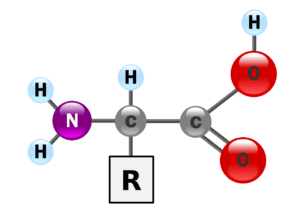
By GYassineMrabetTalk✉This W3C-unspecified vector image was created with Inkscape. – Own work, Public Domain, Link
This means that if every event in the history of the universe were solely devoted to producing combinations of amino acids of the correct length in a prebiotic soup, the number of combinations thus produced would still represent an extremely tiny fraction of the total events necessary to have a minimal chance of producing a single functional protein. And; remember, Son of Earth, this is the chance of getting a single functional protein in the entire universe – not just on Earth. And further, remember that this is just to produce one small protein – not the 250 proteins necessary for the simplest one-celled organism which we have already determined would be about 1041000!”
“All right angel, it occurs to me this is all nonsense.”
“Why is that, Son of Earth?”
“Your explanation is all nonsense because improbable things happen all the time. If I just spread out a shuffled deck of cards on the table, for instance, the chance of that particular configuration is small; in fact, it is 52! (52 factorial)[15] or about 1 chance in 1068! According to your logic, God intervened to produce this particular card pattern because it is so rare! See angel, I can do math too!”
“Son of Earth, the correct analogy would be how difficult would it be for you to take another shuffled deck of cards, spread them on the table, and get exactly the same distribution of cards! Chance must produce not any string of amino acids, but only those strings which are functional. Do you understand the difference?”
“No Angel, I don’t. I think you are only trying to confuse me.”

Deck of Playing Cards – By Imk3nnyma – Own work, CC BY-SA 4.0, Link
“Think of it this way. Let’s say your string of shuffled cards on the table represents a string of amino acids in a functional protein. The chance of producing that exact string of cards is – just like you said – 52! (said like “52 factorial”) – about 1 chance in 1068. Now let’s say there are 1010 (10 billion) combinations possible out of 52 cards that will designate a functional protein; in that case, there would be 1010 / 1068 or 1 chance in 1058 of finding a functional protein by chance even though there are ten billion possibilities that will work!”
“Yeah, well – I’ve done some more research and know that no evolutionary scientist says that proteins arose by chance this way.”
“You are correct, Son of Earth – but the sequence of amino acids in functional proteins came about either by chance – or it did not; if the sequence did not arise by chance, then how could it have arisen?”
“Look, Angel, I have a little bit of knowledge in this area. Suppose the first proteins were much shorter in length than 150 amino acids; life got started with short amino acids and then evolved. As a matter of fact, there is this website that shows that the simplest self-replicating protein is only 32 amino acids long;[16] that could easily have been made by chance! Take a self-reproducing protein and put it in a cell membrane and you’ve got a simple form of life!”
“First, Son of Earth, that combination would rapidly decay as there is no way for it to eat and consume energy.”
“Well, I know – but it’s a good start!”
“Second, a small self-replicating protein doesn’t do anything but self-replicate; in other words, there is no enzymatic function, metabolic function, reproducing function – and it would quickly fall apart.”
“Just a start, Angel!”
“I know, Son of Earth – you have made multiple unsubstantiated speculations. An evolutionary scientist named Sidney Fox tried to imagine the spontaneous formation of proteins from amino acids. He called the chemicals made by the spontaneous formation of amino acid polymers “proteinoids” because they resembled proteins.[17] However, the most difficult aspect of his theory was the observation that the proteinoids were not composed only of polypeptide bonds – as are proteins. Rather, there are many cross-linkages and non-peptide bonds as would be expected during their natural formation – unlike the case with life proteins. It appears that naturally occurring polymers of amino acids do not get longer than 10 amino acids long.[18]
“OK then, Angel – perhaps DNA came first and produced the first protein molecules; it’s hard to know what came first, isn’t it – the proteins or the DNA?”
“You bring up a good point, Son of Earth, since proteins are needed for modern DNA synthesis and DNA is needed for protein synthesis.”
“Ok Angel, during my research, I found out that there has been great interest in the RNA world hypothesis whereby RNA molecules which were also enzymes came first; this means RNA could function both as a source of genetic material (just like DNA does now) and has enzymatic function like modern proteins. So you see, Angel, modern science seems to be solving the mystery of life creation – without your God!”
“First, son of Earth, you recognize this is just a hypothesis – a guess because they are not found outside of living cells today.”
“If this is all true, angel, then why do I always hear that scientists believe life started by chance? It is in all the evolutionary textbooks, on YouTube, everywhere it seems a scientific consensus that life started by chance here on Earth in some prebiotic bond?”
“Son of Earth, it is because those asserting the origin of life by pure chance are not the origin of life researchers – the experts in this field have totally given up on life originating by chance due to the probability arguments I have just related to you.”
“But angel, listen; you still have not stated it could not have occurred, did you? I mean, we are here so there must be an explanation as to how we got here!”
“Of course that is true, Son of Earth. However, what science has – or at least should – always be about is to determine the best explanation of something, not to say that something could or could not happen. The finding that probably would not allow for the creation of life at any place in the universe is nothing new, Son of Earth, as it was confessed by P.T. Mora, a senior research biologist at the National Institutes of Health,
To invoke statistical concepts, probability and complexity to account for the origin and the continuance of life is not felicitous or sufficient As the complexity of a molecular aggregate increases, and indeed very complex arrangements and interrelationships of molecules are necessary for the simplest living unit, the probability of its existence under the disruptive and random influence of physio-chemical forces decreases; the probability that it will continue to function in a certain way, for example, to absorb and to repair, will be even lower; and the probability that it will reproduce, still lower. Statistical considerations, probability, complexity, etc., followed to their logical implications suggest that the origin and continuance of life is not controlled by such principles. An admission of this is the use of a period of practically infinite time to obtain the desired result. Using such logic, however, we can prove anything … When in statistical processes, the probability is so low that for practical purposes infinite time must elapse for the occurrence of an event, a statistical explanation is not helpful.[19]
No sooner had this quotation from a famous scientist 50 years ago appeared in my head did the angel slowly disappear from my room. As the angel faded away, so did the brilliant light surrounding him until I again found myself alone, in bed. Jeff glanced at the clock next to his bed and noticed that only a few minutes had elapsed since he went to bed. It seems as though the entire interview with the angel happened over only a few minutes.
It was clear to me that Jeff had experienced something fundamentally different from the usual dream. A dream does not impart new information, statistical considerations, and long quotes but rather represents no new informational content. Certainly, Jeff was having a hard time determining what it all meant; could it all be real – a real visitation from an angel imparting new information for him to consider – or was he just remembering something he had learned long ago and had long since forgotten.
It was hard to know, but one thing was for certain; it was not going to change his life. Jeff was far too set in his ways; he enjoyed his lifestyle of earning vast sums of money from the financial aspirations of his gullible clients and then enjoying all the pleasures that money could buy. He would certainly not be changing his lifestyle over dreams; he would need much more convincing than from some ‘angel’ – who believed in angels anyway!
After a short conversation, we again parted. Jeff seemed to have regained his composure after imparting his dream experience, convincing himself it was but a dream – perhaps remembrances from his more religious early days. He would put it behind him, try to quickly forget quantum mechanics, protein structures, and molecular function. Who knows how life started; he had a life now and he was going to enjoy it.
References
And enjoy it he did.
[1] Moorhead and Kaplan, Mathematical Challenges for the Neo-Darwinism Interpretation of Evolution
[2] Reidhaar-Olsen and Sauer, “Functionally Acceptable Substitutions”:
[3] Bowie and Sauer, “Identifying the Determinants of Folding and Activity.”
[4]Axe, “Estimating the Prevalence of Protein Sequences.”
[5] http://www.pandasthumb.org/archives/2007/01/92-second-st-fa.html
[6] http://www.uncommondescent.com/news/biologist-douglas-axe-on-evolutions-ability-to-produce-new-functions/
[7] Hoyle and Wickramasinghe, Evolution from Space, 24-27.
[8] http://www.ncbi.nlm.nih.gov/books/NBK2227/
[9] http://www.weizmann.ac.il/plants/Milo/images/proteinSize120116Clean.pdf
[10] There is an additional complication in that the number of different events among particles in the universe is much less than the number of different ways to combine elementary particles; this is true because once events occur, they preclude another possible way for these events to occur. It is the number of events that could actually occur in the history of the universe that determines how many opportunities the universe has to produce a particular outcome by chance. Thus, it is not the total number of combinational possible events (or elementary particles) in the universe that determines the available probabilistic resources, but how many opportunities there are for actual events to occur after other events had occurred.
[11] Demsky, The Design Inference, Chapter 6
[12] Elementary particles included in this calculation include electrons, protons, and neutrons (fermions), because only these particles can form material structures (because they have ‘half0integral spin.’ Thus, it does not count bosons – which cannot form material structures but only transmit energy, and it does not calculate the number of quarks out of which protons and neutrons are made, as quarks are necessarily bound together within these particles. However, even if quarks were individually counted, the total number of elementary particles would change by less than one order of magnitude since there are only three quarks per neutron or proton.
[13] http://www.space.com/24054-how-old-is-the-universe.html
[14] http://www.physicsoftheuniverse.com/numbers.html
[15] https://www.mathsisfun.com/numbers/factorial.html
[16] http://evolutionfaq.com/articles/probability-life
[17] Fox, Sidney W.; Kaoru Harada (14 November 1958). “Thermal Copolymerization of Amino Acids to a Product Resembling Protein”. Science. New Series 128 (3333)
[18] Ferris, James P., Hill, Aubrey R., Liu, Rihe, Orgel, Leslie E. Synthesis of Long prebiotic Oligomers on Mineral Surfaces, Nature: 321, p. 59.

